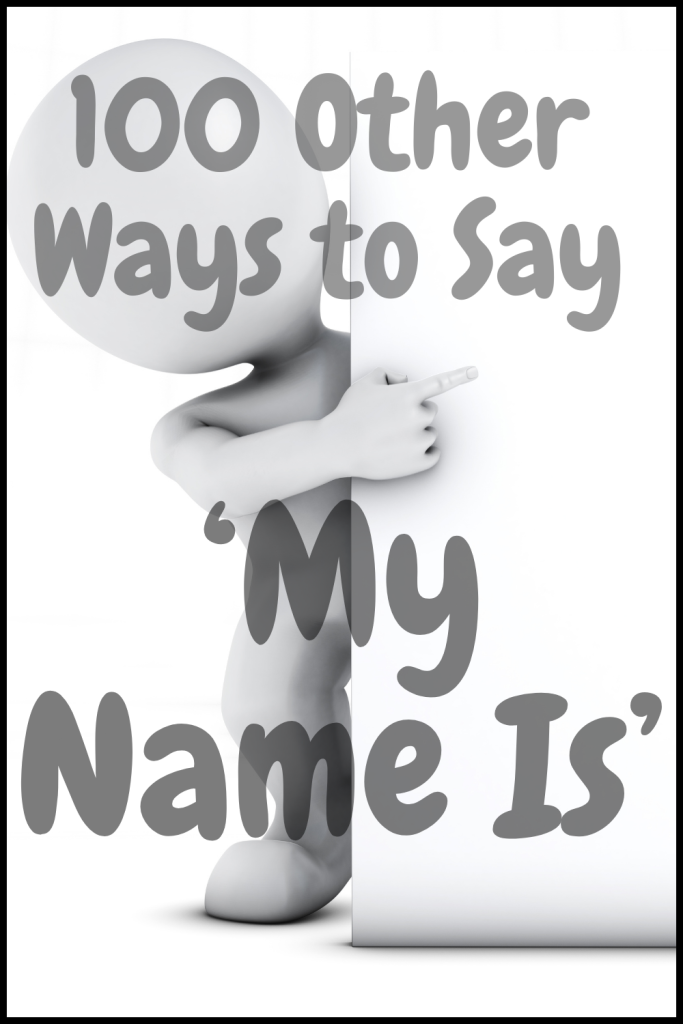Introducing yourself is one of the most fundamental parts of any conversation. Whether you’re meeting someone for the first time, joining a group, or starting a professional interaction, the way you say your name sets the tone. But let’s face it—saying “My name is…” all the time can feel a bit repetitive, even boring.
What if you could spice things up with a fresh approach? What if your introductions could reflect your personality, the setting, or even the cultural vibe of the moment? That’s where this guide comes in.
In this article, we’ll explore 100 other ways to say “My name is,” so you can feel confident and versatile in any situation. From formal to playful, traditional to quirky, these phrases will help you make an unforgettable first impression every time. Ready to master the art of introductions? Let’s dive in!

Check out more phrases for encouragement with these Inspirational alternatives to “quick learner.”
1: Basic Introductions
Let’s start with simple, universally accepted phrases to introduce yourself. These are great for most situations and are easy to use:
- “I’m called…”
Example: “I’m called Alex, and I’m happy to meet you.”
This phrase is casual yet versatile, suitable for friendly or formal contexts. - “My full name is…”
Example: “My full name is Sarah Williams, but you can call me Sarah.”
Perfect for clarifying a longer or formal name while offering a simpler version for ease. - “I go by…”
Example: “I go by Mike, but my full name is Michael.”
This works well when you commonly use a nickname or preferred name.
2: Casual Introductions
In relaxed, informal settings, these phrases can make your introduction feel friendly and approachable:
- “I’m known as…”
Example: “I’m known as Robbie to my friends.”
This adds a personal touch and can hint at a nickname. - “They call me…”
Example: “They call me Jo, short for Joanna.”
Great for playful or light-hearted introductions, often emphasizing a nickname or alias. - “You can just call me…”
Example: “You can just call me Ben.”
Simple and inviting, this phrase encourages others to use a name you’re comfortable with.
3: Formal and Professional Introductions
When introducing yourself in business or formal settings, opt for these polished phrases:
- “Allow me to introduce myself; I am…”
Example: “Allow me to introduce myself; I am Dr. Emily Carter, the project manager.”
This is a confident and formal way to start a professional conversation. - “I am formally known as…”
Example: “I am formally known as Jonathan Edwards, but most people call me Jon.”
This is useful for formal meetings or contexts where titles are important. - “My name happens to be…”
Example: “My name happens to be Amanda Lee, and I’ll be your consultant today.”
Adds a touch of warmth to a professional introduction.
4: Introducing Yourself in Different Languages
In multicultural settings, using another language can leave a great impression:
- French: “Je m’appelle…”
Example: “Je m’appelle Claire, and I’m from Paris.” - Spanish: “Me llamo…”
Example: “Me llamo Juan, and I’d be happy to help.” - Japanese: “Watashi no namae wa…”
Example: “Watashi no namae wa Yuki desu.”
Even if you’re not fluent, these phrases show effort and respect for diverse cultures.
5: Introducing Yourself with Fun or Playful Variations
Add a bit of personality or humor with these light-hearted introductions:
- “The name’s… Bond. James Bond.”
Example: “The name’s Jordan. Just Jordan.”
Mimicking the iconic James Bond introduction can be amusing and memorable. - “I answer to the name…”
Example: “I answer to the name Max, so feel free to call me that.” - “I’ve been known to go by…”
Example: “I’ve been known to go by Leo, though my real name is Leonardo.”
Suggests an air of mystery or fun, adding character to your introduction.
6: Introducing Yourself Through Storytelling
Sometimes, weaving a story into your introduction makes it more engaging. These creative approaches are perfect for casual or semi-formal settings:
- “Back when I was born, they decided to call me…”
Example: “Back when I was born, they decided to call me Rebecca, and it’s stuck ever since.”
This adds a nostalgic or humorous twist to a simple introduction. - “People often say my name fits me perfectly; it’s…”
Example: “People often say my name fits me perfectly; it’s Grace.”
A lighthearted way to reflect personality through your name. - “Here’s an interesting fact about my name; it’s…”
Example: “Here’s an interesting fact about my name; it’s Zane, and it means ‘gift from God.’”
Great for sparking conversation, especially when your name has an intriguing origin or meaning.

7: Regional or Dialectal Variations
In English-speaking countries, introductions can vary depending on regional expressions or dialects:
- “Hiya, the name’s…”
Example: “Hiya, the name’s Charlie. Nice to meet you.”
Common in British English for an informal yet cheerful introduction. - “How’s it going? I’m…”
Example: “How’s it going? I’m Jake.”
This phrase has a casual, friendly tone, popular in American English. - “Alright, I’m called…”
Example: “Alright, I’m called Mia.”
A laid-back introduction often heard in parts of the UK.
8: Introducing Yourself in a Group Setting
When speaking to a crowd, these phrases help you connect with multiple people at once:
- “For those of you who don’t know me, I’m…”
Example: “For those of you who don’t know me, I’m Lisa, the event coordinator.”
Ideal for public speaking or large meetings. - “Let me start by saying my name is…”
Example: “Let me start by saying my name is Adam, and I’m thrilled to be here.”
This works well in both formal and informal group introductions. - “Around here, I’m known as…”
Example: “Around here, I’m known as Coach Dave.”
Perfect for emphasizing a role or nickname in a specific community.
9: Introducing Yourself with Unique Personal Flair
Make your introduction stand out by adding a touch of creativity or personality:
- “Call me what you like, but my name is…”
Example: “Call me what you like, but my name is Bianca.”
A playful way to show confidence and humor. - “Most people know me as…”
Example: “Most people know me as Rick, but my family calls me Ricky.”
Suggests familiarity and openness. - “Officially, it’s…, but you can call me…”
Example: “Officially, it’s Alexandra, but you can call me Alex.”
Helps clarify preferences while being approachable.
10: Introducing Yourself in Digital Spaces
Online introductions require a slightly different tone, often casual but clear:
- “Online, I go by…”
Example: “Online, I go by StarGazer93, but my real name is Lily.”
Perfect for blending your digital identity with your real one. - “In the digital world, I’m known as…”
Example: “In the digital world, I’m known as CodeWizard, but you can call me Sam.”
Great for showcasing your online persona. - “My username is, but my real name is…”
Example: “My username is PixelArtist, but my real name is Maya.”
Useful in gaming or social media settings to clarify your identity.
Why Learning These Phrases Is Important
Learning different ways to say “My name is” goes beyond mere vocabulary—it enhances your ability to connect and communicate effectively. Here’s why it matters:
1. Broader Communication
Language is about adaptability, and knowing varied phrases allows you to fit seamlessly into different contexts. Whether you’re introducing yourself in a casual chat, a professional meeting, or a multicultural setting, these other ways to say my name is ensure you come across as confident and capable.
2. Confidence Building
First impressions are powerful. Having a repertoire of introduction phrases at your fingertips means you’re prepared to handle any situation. This preparedness can boost your confidence and help you leave a memorable impression.
3. Language Learning and Expansion
For non-native English speakers or those learning new languages, these phrases provide a practical way to build vocabulary and understand cultural nuances. Learning creative alternatives also makes language learning more engaging and enjoyable.
4. Cultural Awareness
Showing respect for cultural differences in communication is vital, especially in today’s globalized world. Using regional or language-specific introductions, for instance, demonstrates your effort to embrace diversity and connect meaningfully with others.
5. Personalization and Creativity
Your name is a big part of your identity, and the way you introduce yourself reflects your personality. With varied phrases, you can tailor your introductions to showcase humor, professionalism, or uniqueness, depending on the situation.
Conclusion: 100 Other Ways to Say ‘My Name Is’
Your name is your calling card—a small but mighty piece of your identity that opens the door to countless conversations. By exploring 100 different ways to say “My name is,” you’ve unlocked a treasure trove of possibilities to make introductions more engaging, adaptable, and impactful.
From casual chats to professional meetings, playful banter to cultural exchanges, these phrases allow you to tailor your approach to any situation. They help you connect with others, express your personality, and even break down cultural barriers, all while building confidence in your communication skills.
The beauty of language lies in its flexibility, and now you have the tools to introduce yourself with creativity and flair. So go ahead—experiment with these phrases, make them your own, and let your introductions leave a lasting impression. After all, first impressions matter, and now you can make yours truly unforgettable.
Let your name open doors, spark smiles, and start conversations in 100 unique ways. Practice, personalize, and master the art of introductions—because the way you share your name is the first step to sharing who you are.
Also learn these Game Changing alternatives to ” Happy to Announce”